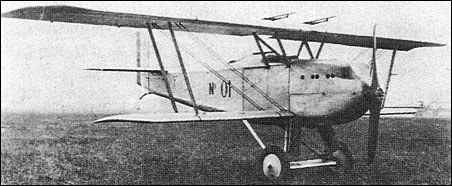|
| The sole single-seat fighter of biplane configuration to
be built by Emile Dewoitine, the D 15 was proposed as a
simpler and more economic (from the structural viewpoint)
fighter than the contemporary D 9, D 12 and D 19
monoplanes. Powered by a 450hp Hispano-Suiza 12Ha
(HS 51) 12-cylinder liquid-cooled Vee engine, the D 15
had fabric-covered metal wings with ailerons on the
upper wing only, the metal fuselage being of steel
longeron and duralumin tube cross-member construction
with fabric-covered sides and light metal upper
and lower decking. Armament comprised two fuselage-
mounted 7.7mm Vickers guns and two 7.5mm
Darne guns mounted on the upper wing centre section.
Flown on 13 August 1924, the D 15 displayed inadequate
longitudinal and lateral stability, and, after
modification, proved to possess a markedly inferior performance to the lower-powered D 19 monoplane during
CEPA (Commission des Essais Pratiques de l'Aviation)
testing at Villacoublay during the autumn of 1924. In
consequence, it was not submitted for STAe evaluation
of 1923 C1 programme contenders held in 1925-26.
 | A three-view drawing (640 x 414) |
| WEIGHTS |
| Take-off weight | 1535 kg | 3384 lb |
| Empty weight | 1040 kg | 2293 lb |
| DIMENSIONS |
| Wingspan | 12.00 m | 39 ft 4 in |
| Length | 7.40 m | 24 ft 3 in |
| Height | 3.54 m | 12 ft 7 in |
| Wing area | 30.00 m2 | 322.92 sq ft |
|
Do you have any comments?
|
| 
COMPANY
PROFILE
All the World's Rotorcraft
|







